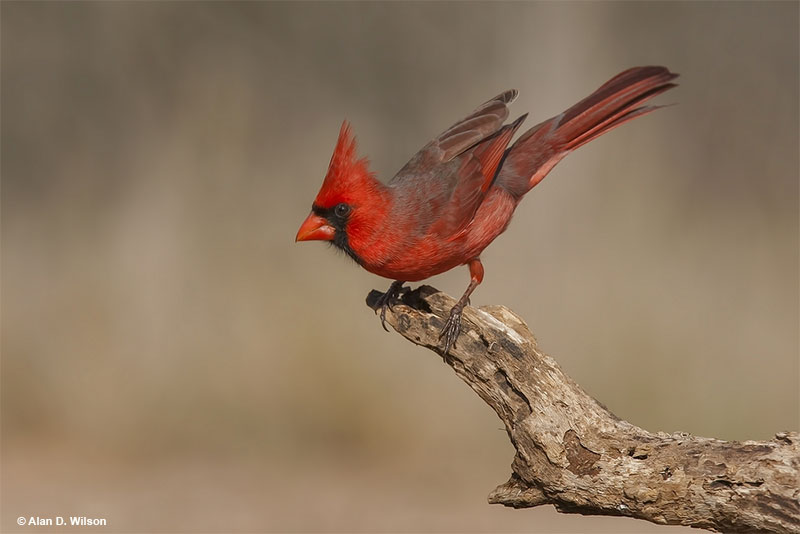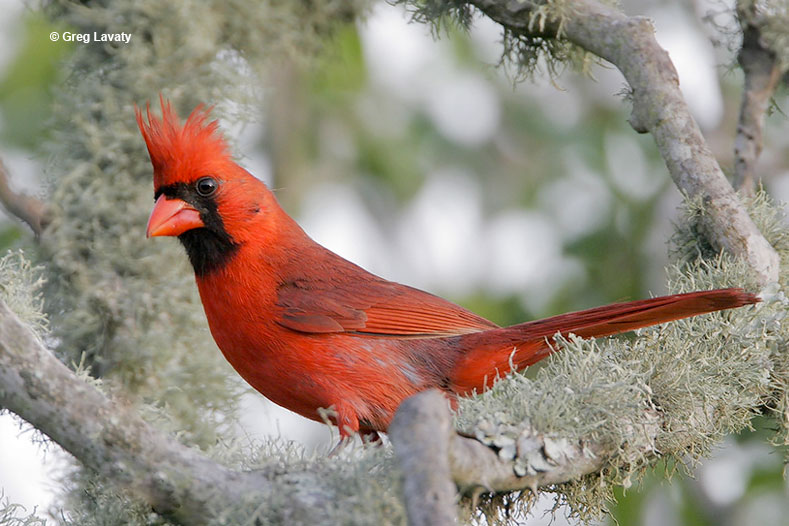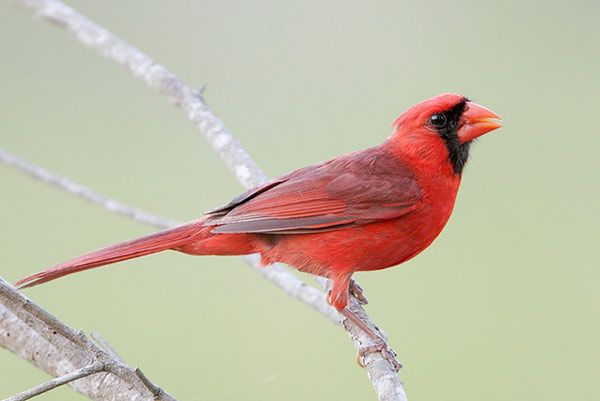
Ohio state bird is a medium-sized crimson red songbird called Northern Cardinal, which is also known as the redbird, common cardinal, red cardinal, or just cardinal.
Ohio itself is a state in the Midwestern United States that places somewhere at the bottom of the list in terms of area and at the top of the list in terms of population when compared to the other 50 states.
It is the 34th largest state by area, being 44,825 square miles large, and 7th most populated, with almost 12 million inhabitants. Ohio’s eastern part is hilly, whereas the western part is flatter. It has hot and humid summers and cool to cold winters.
On this page
History
Northern Cardinal became the Ohio state bird in 1933. The bird was chosen as the official state bird by the Ohio General Assembly due to it being widespread across the state.
However, this was not always the case. In the late 1600s, almost all of Ohio was covered with forests, and Northern Cardinals were rare. As the settlers chopped down the thick woodlands, making it into a more suitable habitat for the cardinals, the birds began to move in and populate the area.
By the late 1800s, they could be found across the state and were so common that people trapped some of them and kept them as pets.
Facts About The Ohio State Bird
- Northern Cardinal happens to be a state bird for 7 states: Illinois, Indiana, Kentucky, North Carolina, Ohio, Virginia and West Virginia
- Northern Cardinals tend to be the first birds to visit bird feeders in the morning and the last visitors in the evening. Ornithologists believe that this is because the low light offers some security from predators. After all, the bright plumage of the birds can’t be seen as well and then there’s less competition with other birds.
- The Northern Cardinal got its name thanks to its crimson-red feathers. It was named after Catholic cardinals because they wear bright red clothing.
- Northern Cardinals mostly eat seeds. You can easily attract one to your garden by putting sunflower seeds, safflower seeds, or cracked corn in your bird feeder!
- During the breeding and nesting season, male Northern Cardinals become very territorial and will attack anything and anyone they perceive as a threat, including their own reflection.
- Northern Cardinals symbolize love, loyalty, life, hope, and restoration and are most commonly associated with the winter season.
Identification
This medium-sized songbird measures around 8.2-9.3 inches in length, weighs between 1.2-2.3 oz, and has a wingspan of 9.8-12.2 inches.
Northern Cardinal’s main characteristics are its bright red plumage, a black mask on its face, and a raised tuft of feathers on its head.

Female Northern Cardinal is slightly smaller and more modest than their male counterpart. They are brownish-orange or olive-colored with red accents in their plumage, mostly on their crest, wings, and tail. Young birds resemble the female, but they can be distinguished by their grayish-black bills.
Northern Cardinal inhabits most parts of the United States east of the Rocky Mountains from southern Canada to Mexico and Central America.
They prefer to live in places that offer dense foliage to hide their nests in, such as edges of the woods, hedges, suburban gardens, thickets, swamps, city parks, streamside thickets, and shrubs in general. You can also meet them in the desert in the southwestern United States.
Northern Cardinal’s nest is a cup 2-3 inches tall, 4 inches wide with an inside diameter of 3 inches. It is made from coarse twigs and leaves, lined with soft bark, and finally bolstered with fine plant material, such as fine grass, pine needles, and hair.
The female builds the nest 1-15 feet above the ground in a well-hidden area in dense shrubs, vines, or low trees and lays 2-5 eggs. The eggs are about an inch long and wide, are grayish, greenish-white, or pale blue in color, and are speckled with pale gray to brown blotches.
What Does The Ohio State Bird Sound Like?
The Ohio state bird communicates via vocalization and physical displays, such as tail flicks and lifting and lowering their crest. They have many different songs from region to region because they learn their songs.
Both the male and female cardinals sing, and the songs themselves typically sound like high-pitched alarms. Their songs consist of metallic whistles that usually end in a slow trill and last about 2-3 seconds. Common phrases include whoit-whoit-whoit, whacheer, cheer-cheer-cheer and purty-purty-purty.
You can hear Northern Cardinals call when they’re trying to chase intruders from their territory, warn others that predators are near, during courtship, and when approaching the nest with food. Their calls are a single or a series of short high-pitched metallic chips.
Behavior
Northern Cardinals are mostly herbivores. They prefer to eat grain, fruit, berries, buds, and different seeds, especially those that are easily husked but also eat insects.
Cardinals forage on or near the ground and sing, preen, and survey the area from a high branch. When one of them is agitated, it lifts its crest but lowers it back down when it’s resting and calm.
The breeding season lasts from March until September. During this time, the Northern Cardinals are easily agitated and become aggressive. They can attack anything they perceive as a threat, including their own reflection, and usually fly around in pairs.

When a predator comes near the nest, they will give a short alarm call and dive toward it to scare them away. During the fall and winter, however, cardinals flock together and can even be seen foraging together with birds from other species. While foraging, young birds give way to adults and females typically give way to males.
These Ohio State birds are serially monogamous. They stay together for one breeding season and then find a new mate, although some mate for life. To attract a female’s attention, the male will hop around her and flutter his wings, tail and wings partly spread out. The male will try to gain the female’s favor by offering her various seeds, worms, and insects.
The female chooses the nesting site, the male follows along on the search. The male Northern Cardinal gathers the materials and the female builds the nest.
Northern Cardinals are not migratory, they stay put year-round.
Where Can You See Ohio’s State Bird?
Northern Cardinals are incredibly common across several states – all across the eastern side of the United States and some southwestern areas as well.
In their natural habitats, however, these little cardinals are not too picky. Northern Cardinals like open areas, but in order for them to nest, they need some denser vegetation as well. These common backyard birds can be spotted in all kinds of environments from backyards to thickets.
They are not shy and usually make their presence known!
Other Common Birds In Ohio
Ohio is known for its vast bird population – with different kinds of habitats, this is a bird paradise! Ohio is known for its songbirds, woodpeckers, hawks, and even ducks, but it shouldn’t come as a surprise, but Northern Cardinals happen to be the most common birds in Ohio.
Here are some of the most common species:
- Northern Cardinals
- Blue Jays
- American Robins
- American Goldfinches
- Mourning Doves
- Song Sparrows
- Red-bellied Woodpeckers
See more – Most common birds in Ohio
Frequently Asked Questions
What is the state flower of Ohio?
The state flower of Ohio is a Large-Flowered Trillium. These flowers were chosen as state symbols in 1986.
What is Ohio state animal?
Ohio state animal is the White-Tailed Deer, chosen in 1988. These deers are state animals of nine other states, including South Carolina, Nebraska, and Georgia.
What insect is the Ohio state symbol?
Ohio state insect is the ladybug. The ladybug was chosen as a state symbol back in 1975.
